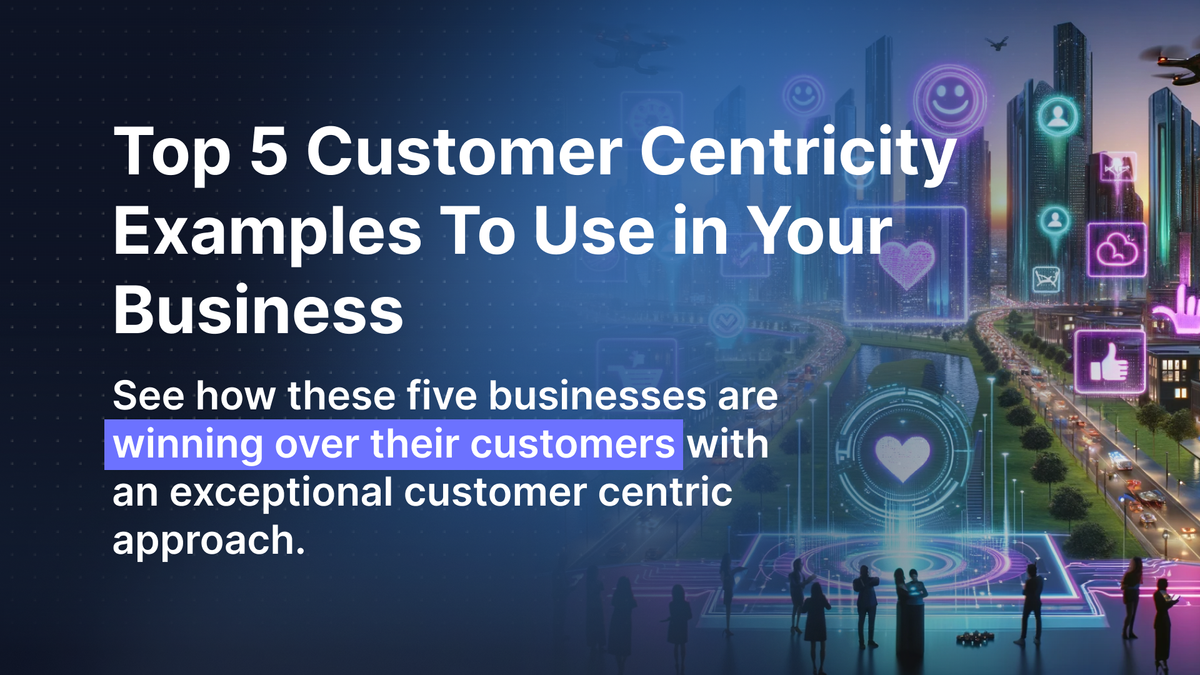Forget about boring sales tactics! See how these five businesses are winning ...

The business marketplace is becoming increasingly competitive and saturated than ever. This calls for a customer-centric business strategy prioritizing customer experience over anything else. Exploring some of the best customer-centricity examples can help you understand that making sales is just not enough to thrive among your competitors. Research shows that customer-centric companies are 60% more profitable than those with a generic approach
So, what is a customer-centric approach, and how can it help you completely transform the way you have been doing business? Keep reading until the end to find out.

Customer centricity is a business strategy based on putting your customer at the center of your business to provide a positive customer experience and build long-term relationships. Being a customer-centric organization means understanding a customer’s wants, needs, and preferences and aligning your products, services, and overall business operations to meet those preferences.
Instead of focusing on selling products, customer-centric businesses emphasize solving customers' problems. Companies leverage different resources such as artificial intelligence, CRM platforms, feedback, and surveys to constantly improve their customers' service. Imagine a restaurant; instead of having a fixed menu, they ask about your dietary restrictions and preferences to recommend the perfect dish. This is exactly what customer-centricity is!

The quote ‘customer is king’ has never been more apt. Today’s customers have high expectations and plenty of choices. In this crowded marketplace, customer experience (CX) makes a business stand out from its competitors. Here is why having a customer-centric mindset is not an option but an essential factor for your business’s success.
People are more likely to become repeat buyers when they feel valued and satisfied by the customer experience. This extends their relationship with your business, increasing the value they bring over time. According to Microsoft, 96% of customers say that customer service is important in their choice of loyalty to a brand.
By going beyond leads and conversions, you will better understand your audience’s emotions, needs, and pain points throughout their interaction with your business. This gives you more chances to engage with them and provide them with a personalized experience that fits their needs.
Happy customers are your best brand ambassadors who will recommend your products and services to their network. It also helps customers become more informed and confident in buying decisions. According to Forrester's research, brands that do best with CX bring in 5.7% more revenue than their counterparts.
Customer-centric business strategies retain customers by addressing their concerns promptly and resolving issues effectively. This builds trust and loyalty, reducing churn and ensuring a consistent flow of returning customers. Research done by Bain and Company shows that a 5% increase in customer retention can increase profits by 25%.
Here, we have shortlisted the five best customer-centricity examples in businesses for you to get inspired and design your customer-centric strategies.
Amazon’s success is deeply connected with its customer-centric approach. It was one of the first E-Commerce companies to embrace personalization in early 2000, and it remains the major driving force behind its success.
Amazon uses collaborative filtering techniques to analyze your browsing history, past purchases, and items left in the cart. This allows them to suggest products you might be interested in, such as the ‘Customers who bought this also bought’ section. These personalized suggestions can make the shopping journey more convenient.
Amazon’s user interface is designed for intuitive navigation. Search bars, clear categories, and well-placed filters make it easy to find what you are looking for regardless of your device (Phone, PC, Laptop).
Multiple customer support channels such as live chat, email, and phone give easy access to help and ensure a smooth customer journey and post-purchasing support.
With 471 stores around the globe, Ikea is one of the finest customer centricity examples in both e-commerce and in-store businesses. Here is how they curate an exceptional customary journey for their audience.
Ikea’s website contains articles and guides on home decor and interior design to help you design your dream home. If you need an expert opinion, consult with their interior designer online or in-store at your convenience.
The Ikea app uses augmented reality to virtually place furniture in your place. This gives you a clear picture of how it will look in your house before you buy it.
Shopping at Ikea is designed to be enjoyable. They offer cafes and rest areas for breaks and even free child care to keep your little ones engaged. It's all about making you feel comfortable and welcomed.
For Loreal, client-centricity means providing a hyper-personalized customer experience in the comfort of their home. Loreal Perso is a 3-in-1 at-home personalized beauty system launched in 2020. Perso leverages cutting-edge AI technology to deliver a truly personalized experience:
The Perso app uses advanced AI to analyze your skin through photos you upload. It identifies concerns like wrinkles to create a customized profile.
Perso goes beyond just your skin. It evaluates environmental conditions like geo-location, temperature, pollen levels, and UV index to tailor formulas accordingly.
Based on a detailed analysis, Perso creates personalized formulas. Pre-filled cartridges dispense the perfect single dose of foundation or lipstick, ensuring you get exactly what your skin needs.
Hilton Honors, the loyalty program offered by Hilton Hotels and Resorts, is one of the excellent customer centricity examples in hospitality. Hilton uses this program to cultivate strong customer relationships and drive loyalty.
Hilton Honors remembers guests' preferences, such as desired room type or preferred locations. This allows for a more tailored and personalized experience.
Guests earn points for their stay, which can be redeemed for free nights, upgrades, and other perks.
The Hilton Honors app facilitates mobile check-in and keyless entry, streamlining the guest experience.
Asana, a project management tool, stands out as one of the prime customer-centricity examples in the SAAS industry. It can be a powerful tool for businesses to embrace a customer-centric approach through proactive problem-solving. Here is how:
Asana encourages clear communication between teams. By consolidating customer interactions (emails, chats) in tasks, teams can better understand customers' needs and pain points.
Mapping task dependencies in Asana allows the team to identify potential roadblocks in advance. This helps them to develop proactive solutions to ensure deadlines are met, and customers' expectations are exceeded.
Asana can be used to manage dedicated feedback channels for easy collection and organization of customer input. This data can refine processes and features, creating a more customer-centric product or service.
This article highlights some prominent customer centricity examples in business, emphasizing its role in increasing customer lifetime value, enhancing customer journey, driving sales and revenue, and improving customer experience. While customer-centric websites, loyalty programs, or proactive problem-solving can be a driving factor behind a brand’s success, the use of AI customer service can further streamline this process.
Incorporating AI chatbot customer service can further enhance customer centricity by providing 24/7 customer service, answering FAQs, and collecting customer feedback to improve products and services.
Check out Aidbase and learn how to design your customer-centric systems with AI-powered customer service.